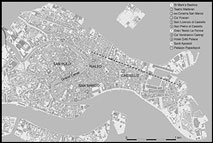Published online by Cambridge University Press: 11 December 2018

In a recent Antiquity article, Ammerman et al. (2017) suggest that three radiocarbon dates on seventh- or eighth-century AD samples obtained by coring beneath St Mark's Basilica—including two peach stones—illuminate the earliest settlement of the historic centre of Venice. Excavations at several other locations, however, have yielded in situ settlement remains at least as old as the peach stones, some of which are securely dated by a floating tree-ring chronology and radiocarbon dates from stratified structural samples. Here, the authors summarise this evidence, and propose that a large area of the historic centre may have been settled by, or during, the mid seventh century AD.
Please note a has been issued for this article.